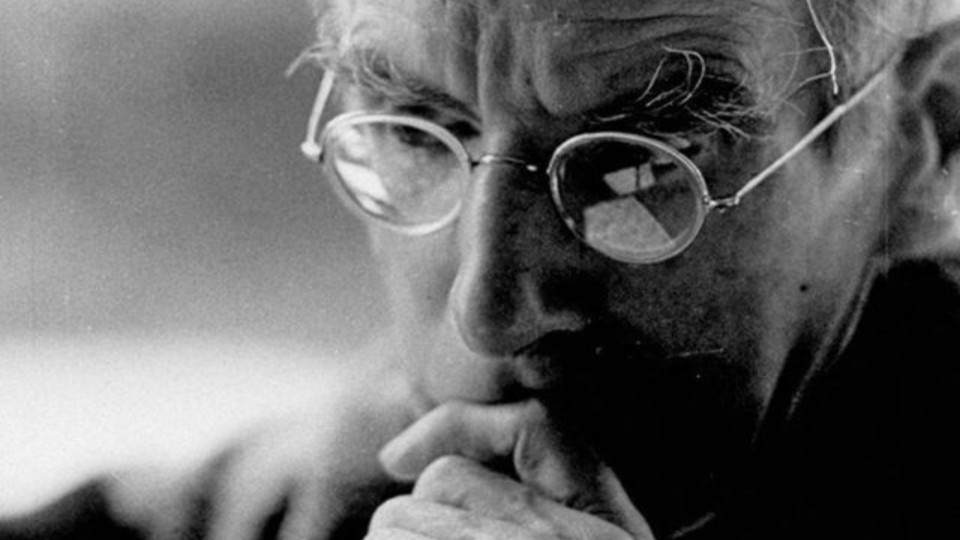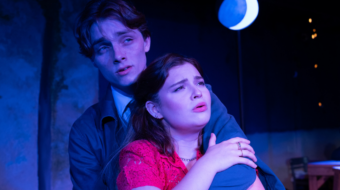
Sean O’Casey’s play The Shadow of a Gunman premiered 100 years ago, on April 12, 1923, at Dublin’s national Irish theatre, the Abbey Theatre. The theatre, which grew out of the Irish Renaissance movement for the renewal of Irish literature in 1904, encouraged new Irish writers and provided a platform for the exploration of progressive ideas on stage. The Shadow of a Gunman is the first of O’Casey’s three Dublin plays, which examine the maturity and fortunes of the people at three important moments in Irish history—the Easter Rising (1916), the War of Independence (1918-21), and the Civil War (1922-23)—all of which O’Casey experienced.
O’Casey did not turn to playwriting until he was nearly 40 years old, around 1920. Prior to that, he had participated in national and class struggles for two decades as a champion of Irish-language culture, a militant trade unionist, and a socialist activist. Then, from the early twenties until his death in 1964, he devoted himself to writing drama.
He was the first English-speaking playwright of proletarian origin to enter the stage of the world theatre. His plays are about the struggle for the emancipation of the Irish people, and thus implicitly of all working people, from poverty, ignorance and exploitation, for the creation of a new, humane society.
Born in Dublin in 1880, O’Casey came under the influence of Jim Larkin, the legendary trade unionist, together with James Connolly, the driving force in this class struggle, even before the great lockout of 1913. From then on, O’Casey’s maturation as a class-conscious socialist and communist internationalist can be traced. At the same time, he remained true to the best traditions of Irish republican nationalism.
In the years leading up to the 1916 Rising, disagreements arose between O’Casey and Connolly, who had taken over leadership of the left wing of the movement from Larkin, over Connolly’s effort to ally militant workers with the patriotic bourgeois nationalists who had been their class enemies in the 1913 struggle. For this reason, O’Casey did not take part in the Easter Rising and no longer found a place in that organized movement.

Increasingly, he became a commentator on contemporary developments from a revolutionary-proletarian perspective, while continuing to earn his living as a worker. At the same time he educated himself autodidactically. Between 1920 and 1922, he decided to turn to drama as a way for revolutionary action.
At this point he saw his growing fears for the fate of the Irish Revolution tragically confirmed. Ireland had been one of the storm centers of the revolutionary decade from 1911 to 1921. But that revolution was betrayed and the people defeated for the time being. The situation needed to be analyzed.
The year 1913 was the decisive experience in which the Irish workers became conscious of themselves as a class, something O’Casey had understood. But by 1922, the Irish bourgeoisie had betrayed the people and, along with the British government, established the Irish Free State—a fatal development that led to a tragic and bloody civil war.
In his Dublin plays, The Shadow of a Gunman (1923), Juno and the Peacock (1924), and The Plough and the Stars (1926), O’Casey sets out to show the Irish working class with all its weaknesses, illusions, and self-deceptions what he believed had contributed to this defeat. It is a critique set against the backdrop of the victorious Russian Revolution, which also allows him to create a tension between the actual and the possible. There emerges a deep conviction of the people’s ability to revolutionize reality.
The Shadow of a Gunman
The play is set in the midst of the War of Independence, in May 1920, in Seumas Shields’s room in a Dublin tenement. Thirty-year-old Donal Davoren, writer of romantic verse, shares a room in this Dublin slum with Seumas, a 35-year-old peddler and onetime patriot who has now retreated into religion, superstition and bed. The slum dwellers are convinced Davoren is an armed IRA man on the run and assure him of their support. Flattered, he does not contradict them, especially when the ardent young patriot Minnie Powell falls in love with him.
The slum dwellers further include: Mr. Grigson, an alcoholic loyalist (to England) who is adored by his wife Mrs. Grigson; Mrs. Henderson, admirer of the small clerk Mr. Gallogher and his imagined literary skills; and, in addition to Minnie Powell, Tommy Owens, who repeatedly declares he is willing to die for Ireland. They all crave some glamour from the supposed gunman Davoren.
A friend of Seumas, Maguire, arrives and leaves a bag apparently containing peddler’s goods. When news arrives that Maguire has been killed in a robbery, it becomes clear that he was a genuine IRA gunman. British troops storm the tenement. Seumas and Davoren discover to their horror that the bag contains bombs. The men are now desperate to get rid of the bag, and Minnie bravely hides it in her room without the men stopping her. The soldiers terrorize the tenants and discover the bombs. Minnie is arrested and accidentally shot when the IRA ambushes the British while they are taking Minnie away. The women, especially Mrs. Henderson, stand up to the invaders while the men grovel before them. After the disaster, Davoren mocks his own and Seumas’s spinelessness. Seumas insisted that the ominous tapping he had heard on the wall previously was an ill omen.
O’Casey portrays life in the Dublin slums as characterized by poverty and lack of prospects, war, terror, and violent death. Their inhabitants do not seem to offer much resistance. The actual freedom fighter Maguire passes unrecognized through their midst, touching them only briefly, in contrast to the mechanisms of oppression that are massively present, especially the British army.
O’Casey, in contrast to the romantic image of a united, heroic people, draws disunity, escapism, disillusionment on the one hand, and illusions on the other, lack of leadership, and the inability to realistically confront one’s own situation.
How is this translated artistically?

One scene at the beginning of the play involves a written complaint by Mr. Gallogher to the IRA about some neighbors, people of his own class, in which he asks that the IRA intervene against them with force. Mr. Gallogher’s rebellion takes the form of an awkwardly worded letter in which he cannot even clearly articulate his request. Nevertheless, he earns the admiration of other neighbors. This fascination with the supposed power of the word, of form, of ritual, of hocus-pocus, is reinforced by a lack of real education and religion. Minnie also believes in the power of the word, that her love for Davoren is magically secured by typing both their names together on a piece of paper. The patriotic songs that echo throughout the play and substitute for action also fall into this category.
But the characters in this play resist sober engagement with the reality of their situation in other ways, too. For example, Mrs. Grigson submits to the biblical dogma, “The woman shall be subject to her husband,” even though Mr. Grigson spends a lot of time at the pub and she perceives him more realistically in his absence.
Minnie Powell also defies her own common sense: she falls in love with the romantic myth of the freedom fighter and his devoted lover, who is willing to sacrifice her life for him—an image she has absorbed from an early age in songs and stories. She, too, does not realize that Maguire is the real gunman. She herself creates the shadow of a gunman that destroys her: her heroism is empty—she too becomes the shadow of a heroine. Minnie’s subservience to Davoren finds its parallel in Mrs. Grigson. Courage and devotion, which ought to serve people in their liberation, here turn into the opposite and contribute to their destruction.
O’Casey creates multiple parallels in this play, which on the one hand serve to generalize the action, but also contribute to a comic-grotesque aspect to the tragedy. This helps create a distance from the action and the characters, which allows the audience to see more clearly what the playwright is saying, ultimately helping them in confronting these weaknesses.
The belief in the power of the word, of the sign, is put to the test in the second act and proves useless. Neither the holy statues and images in Seumas’s room nor their “loyalist” counterparts protect the tenants from the arbitrariness of the British soldiers, who throw the Bible on the floor and force Grigson to pray and sing for their amusement—now the Word is controlled by the enemy. Even Davoren’s name on Minnie’s chest does not protect her from the fatal bullet.
Dyin’ for the gunmen
Donal Davoren and Seumas Shields are people of intellectual and cultural ambition and insight who could be leaders in the eyes of the community from which they came as they share certain qualities with the people. Seumas Shields was once an active and cultured, well-read patriot who “taught Irish six nights a week.” He asks Davoren to clarify a question about Orpheus, but the latter does not know the answer. He also knows Shakespeare and is capable of deep insight.
Davoren: “I remember the time when you yourself believed in nothing but the gun.”
Seumas: “Ay, when there wasn’t a gun in the country; I’ve a different opinion now when there’s nothin’ but guns in the country…. An’ you daren’t open your mouth, for Kathleen ni Houlihan is very different now to the woman who used to play the harp an’ sing ‘Weep on, weep on, your hour is past,’ for she’s a ragin’ divil now, an’ if you only look crooked at her you’re sure o fa punch in th’ eye. But this is the way I look at it- I look at it this way: You’re not goin’—you’re not goin’ to beat the British Empire—the British Empire, by shootin’ an occasional Tommy at the corner of an occasional street. Besides, when the Tommies have the wind up—when the Tommies have the wind up they let bang at everything they see—they don’t give a God’s curse who they plug….
“It’s the civilians that suffer; when there’s an ambush they don’t know where to run. Shot in the back to save the British Empire, an’ shot in the breast to save the soul of Ireland. I’m a Nationalist meself, right enough—a Nationalist right enough, but all the same—I’m a Nationalist right enough; I believe in the freedom of Ireland, an’ that England has no right to be here, but I draw the line when I hear the gunmen blowin’ about dyin’ for the people, when it’s the people that are dyin’ for the gunmen! With all due respect to the gunmen, I don’t want them to die for me.”
Yet there is a contradiction between insight and action. Seumas’s insights degenerate into unproductive rituals that replace action. Seumas has withdrawn from life and responsibility; he has no real loyalties or relationships with others. His education has dwindled to pedantic knowledge. Religion is no help either—British soldiers mock him and his holy statues. He also fails to recognize Maguire’s true character, although there are signs of his membership in the IRA. Seumas can no longer match form with content. Had he recognized Maguire as a gunman, Minnie’s death might have been avoided. Seumas, too, is a shadow of what he might have been.
The national liberation movement fails to reach the broad masses of the people: Maguire moves through them fleetingly and unrecognized. The separation of the liberation movement from the mass of the people, its tendency to put all its faith into the ritual of the gun, is evident in Seumas’s statement about the all-powerful gun:
“I wish to God it was all over. The country is gone mad. Instead of counting their beads now they’re countin’ bullets; their Hail Marys and Paternosters are burstin’ bombs—burstin’ bombs, an’ the rattle of machine-guns; petrol is their holy water; their Mass is a burnin’ buildin’; their De Profundis is ‘The Soldiers’ Song,’ an’ their creed is, I believe in the gun almighty, maker of heaven an’ earth—an’ it’s all for ‘the glory o’ God an’ the honour o’ Ireland.’”
Davoren initially appears as the antithesis of his roommate—an aspiring poet, free of religion and superstition. And yet there are parallels. For example, both are capable of important insights, and both flee from the consequence: action consistent with those insights. Davoren recognizes Minnie’s willingness to act. Unlike the others, he is able to see beyond the surface. He has the will and the ability to free others from their ignorance.

But Davoren does not live up to his responsibility. He flees from life and never leaves his room, even when Minnie is arrested. He uses the poetry of the revolutionary Shelley mainly to take refuge in self-pity. Shelley was a highly political poet, but Davoren, wanting to emulate him, says, “I know nothing about the Republic; I have no connection with the politics of the day, and I don’t want to have any connection.” The traditional rebel songs offer no poetic response to the exigencies of the times, and he dismisses all attempts to grapple with Ireland through poetry: “Oh, we’ve had enough of poems, Minnie, about ’98, and of Ireland, too.” He fails to see a heritage with which he could connect. (In fact, several of the leaders of the 1916 uprising were poets.) And he takes refuge in art for art’s sake, in the ivory tower idea: “Damn the people! They live in the abyss, the poet lives on the mountain-top.”
Yet Davoren will not help the people to escape from this abyss. Instead of arriving at realism, he too develops a deadly fascination with “form,” a confusion of shadow and substance. And although he is more linguistically aware, his poems are as conventional in their phrasing as Gallogher’s letter, “Or when sweet Summer’s ardent arms outspread,/ Entwined with flowers,/ Enfold us, like two lovers newly wed.…” What is true of the peddler is also true of the poet. What is true of the Catholic republican is also true of the Protestant loyalist.
When Davoren shows off to Minnie about his supposed battles, he is as self-important and self-absorbed as Grigson or Tommy, though he is more aware of the danger of this illusion—hence, his responsibility for the tragedy is all the greater. Davoren realizes this to some degree when Minnie is killed: “It’s terrible to think that little Minnie is dead, but it’s still more terrible to think that Davoren and Shields are alive!”
Maguire, however, is not an alternative either. He makes only a fleeting appearance and leaves the impression of thoughtlessness and irresponsibility more than anything else. He is as responsible for Minnie’s death as Davoren is. The threatening shadow of the real and the fake gunman lies over the whole scene. It confirms Seumas’s assertion that the gunmen do not die for the people, but the other way around. Minnie is shot not by the British but by the “real” gunmen.
The tragedy is not that potential leaders are ahead of the times, but that the people have no leaders who are in tune with the people and the times. Their best leaders were executed in 1916. There is no sign that the masses can produce adequate leaders in the foreseeable future. Nevertheless, all the human qualities necessary for liberation are there and embodied in the people, in their contradictions, even if they manifest themselves at the moment only as potential.
These include the qualities of women, their lack of self-absorption, their capacity for loyalty, responsibility and self-sacrifice, their courage, their undamaged interest in poetry. Minnie is the most concentrated expression of this, but it is not about women versus men. Important qualities are common to both genders. A spontaneous solidarity, for example, prevents all the slum dwellers from betraying Davoren. Minnie and Maguire sacrifice their lives for something beyond themselves that they believe will bring liberation. Davoren learns painfully from his experiences, even reaching a certain self-knowledge. And potential is perhaps also to be found in the play’s language with its irrepressible power and inventiveness.
In his creation of contradictory, realistic characters, O’Casey creates a growing awareness of a possible alternative inherent in things as they are. He exposes productive potential and makes clear that destinies could be steered in a different, better direction. This is best expressed in Davoren, about whom the audience is not sure which way he will go, until the very end.
We hope you appreciated this article. Before you go, please support great working-class and pro-people journalism by donating to People’s World.
We are not neutral. Our mission is to be a voice for truth, democracy, the environment, and socialism. We believe in people before profits. So, we take sides. Yours!
We are part of the pro-democracy media contesting the vast right-wing media propaganda ecosystem brainwashing tens of millions and putting democracy at risk.
Our journalism is free of corporate influence and paywalls because we are totally reader supported. At People’s World, we believe news and information should be free and accessible to all.
But we need your help. It takes money—a lot of it—to produce and cover unique stories you see in our pages. Only you, our readers and supporters, make this possible. If you enjoy reading People’s World and the stories we bring you, support our work by donating or becoming a monthly sustainer today.










